Trezor Login: Complete Beginner’s Guide to Secure Crypto Access
Learn everything about securely accessing, managing, and verifying your cryptocurrency using Trezor’s login and authentication ecosystem.
What Is Trezor Login?
Trezor login refers to the process of accessing your crypto accounts, dashboards, and wallet settings using a Trezor hardware wallet. Instead of using passwords—which can be stolen, leaked, reused, or phished—Trezor enables a secure, device-based authentication mechanism.
When you interact with crypto platforms, exchanges, or Trezor Suite, your login is verified by your hardware wallet. This ensures private keys never leave the device. Everything remains isolated through a mechanism known as cold authentication, one of the safest models used in the Web3 ecosystem.
“Security begins where passwords end.” — A principle Trezor design philosophy is built on.
How Trezor Login Works
Understanding Trezor Login starts with a basic idea: your private keys never leave your device. Your computer, phone, or browser only interacts with public data. This separation ensures virtually zero exposure to cyber threats.
1. Connect Your Trezor Device
You plug in your Trezor wallet via USB or connect through Trezor Suite. Your computer detects it as a secure accessory.
2. Confirm Login Request
Any login attempt triggers a device confirmation. You approve or deny it. This builds a trusted “handshake” between Trezor & your apps.
3. Local Signing on Device
Trezor signs the authentication request locally. Your recovery seed, private keys, and security data remain untouched and offline.
4. Access Granted
You’re securely logged in. No passwords. No risk of remote hijacking. Only hardware-level validation.
Password Login vs. Trezor Login
Here’s how Trezor login compares to traditional password-based systems:
| Feature | Traditional Login | Trezor Login |
|---|---|---|
| Security | Weak, vulnerable to hacks | Hardware-level protection |
| Phishing Risk | High | Near zero |
| Password Storage | Centralized | None required |
| Private Key Exposure | Possible | Never leaves device |
Security Best Practices for Trezor Login
- Never store your recovery seed online.
- Use Trezor Suite only from official sources.
- Avoid browser extensions claiming to be Trezor support.
- Use a strong, unique PIN for your device.
- Enable passphrase protection for added security.
Important Crypto Terms
These terms naturally connect with Trezor login technologies:
- Cold Storage – Storing assets entirely offline.
- Seed Phrase – The 12–24 words used to recover your wallet.
- Hardware Authentication – Login verification using a physical device.
- Web3 Security – Decentralized identity and wallet protection methods.
Frequently Asked Questions
A: No. For maximum security, the device is required for all login processes.
A: Yes. You can recover access using your seed phrase on a new Trezor or compatible wallet.
A: Absolutely. Hardware login protects at a deeper level than SMS, app codes, or email-based verification.
Conclusion: Why Trezor Login Matters
Trezor login is far more than a simple access method—it is a foundational layer of modern crypto security. By verifying identity using hardware-level cryptography, it keeps your crypto free from phishing attacks, password leaks, malware, and unauthorized intrusions. Whether you're new to crypto or a long-time investor, using Trezor login ensures that your assets remain entirely under your control.
In the ever-evolving world of Web3, wallet security is non-negotiable. Choosing Trezor means choosing confidence, independence, and long-term protection for your digital wealth.
